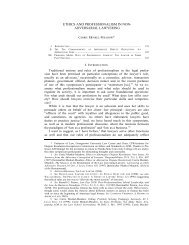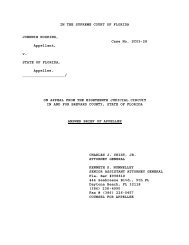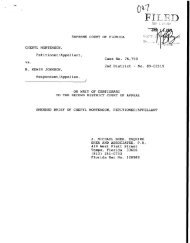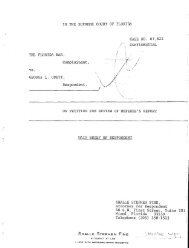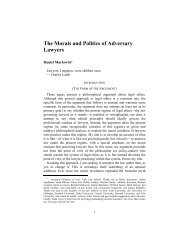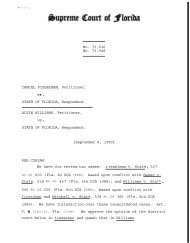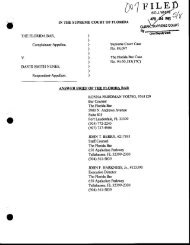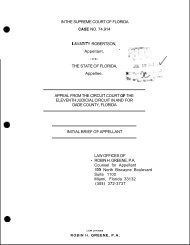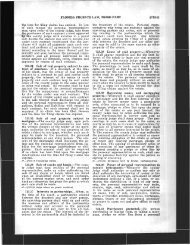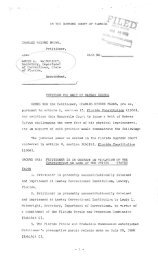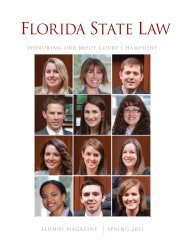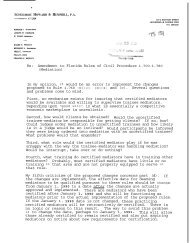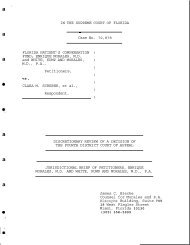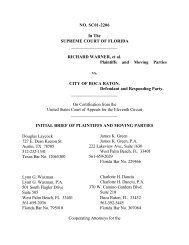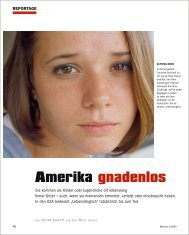Article PDF - Florida State University College of Law
Article PDF - Florida State University College of Law
Article PDF - Florida State University College of Law
- TAGS
- www.law.fsu.edu
Create successful ePaper yourself
Turn your PDF publications into a flip-book with our unique Google optimized e-Paper software.
2007] OFF OF THE PEDESTAL AND INTO THE FIRE 169<br />
Part II <strong>of</strong> this Note will explore the site-specific art movement to<br />
gain a better understanding <strong>of</strong> the legal issues that can arise when<br />
site-specific artists choose to forever tie their work to fixed locations.<br />
Next, Part III will look at the development <strong>of</strong> both foreign and domestic<br />
legal treatment <strong>of</strong> visual art to examine the types <strong>of</strong> protections<br />
that exist for visual artists. This Note will then address the<br />
Phillips decision in Part IV and explain why the First Circuit’s decision<br />
stripped site-specific artists <strong>of</strong> more than just the ability to prevent<br />
removal <strong>of</strong> their work from a specific location. Part V will discuss<br />
the legal future <strong>of</strong> site-specific art in light <strong>of</strong> the Phillips ruling<br />
and suggest ways that artists and property owners can better deal<br />
with the hurdles that arise when site-specific art is designed and installed<br />
on real property.<br />
II. THE SITE-SPECIFIC ART MOVEMENT<br />
Parties unexpectedly affected by site-specific art can range from<br />
bovines to city planners. In Garrison, New York, a one-hundred-andforty-acre<br />
farm recently became the site <strong>of</strong> an exhibit featuring<br />
thirty-five site-specific art pieces. 7 The exhibit shared space with a<br />
herd <strong>of</strong> Black Angus cattle that roamed the farm. The cows responded<br />
to the objets d’art with curiosity and a healthy appetite:<br />
A silver, spaceshiplike sculpture made by Gregory Slick has been<br />
dented by the cows; a series <strong>of</strong> large, rust-covered Styr<strong>of</strong>oam balls<br />
made by Grace Knowlton gets nudged around almost daily. A<br />
three-part sculpture <strong>of</strong> a peace sign by Justin Allen keeps being<br />
upended. One piece, a sculpture <strong>of</strong> decorative grasses by Pat Laltrella,<br />
has been eaten twice, and the area where the sculpture once<br />
was now sits barren. 8<br />
“In our prospectus to the artists, we made it clear that the pieces had<br />
to be cow friendly—no cables, no pointy edges, no holes,” said one <strong>of</strong><br />
the organizers <strong>of</strong> the exhibit. “What we didn’t realize was that everything<br />
also had to be cow pro<strong>of</strong> . . . . [The cows are] very curious.” 9 The<br />
exhibit was sited on private land with the permission <strong>of</strong> the property<br />
owner, an environmentalist and prominent community figure. 10 Even<br />
with the unexpected bovine interferences, the farm owner has appreciated<br />
the site-specific art. In discussing the exhibit, he explained<br />
that he “love[s] having an opportunity for people to come up and<br />
7. Abraham Streep, At a Sculpture Exhibition, the Cows Come Home, N.Y. TIMES,<br />
Sept. 24, 2006, § 14WC, at 12.<br />
8. Id.<br />
9. Id.<br />
10. Id.



